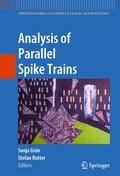
Solid and transparent data analysis is the most important basis for reliable interpretation of experiments. The technique of parallel spike train recordings using multi-electrode arrangements has been available for many decades now, but only recently gained wide popularity among electro physiologists. Many traditional analysis methods are based on firing rates obtained by trial-averaging, and some of the assumptions for such procedures to work can be ignored without serious consequences. The situation is different for correlation analysis,the result of which may be considerably distorted if certain critical assumptions are violated. The focus of this book is on concepts and methods of correlation analysis (synchrony, patterns, rate covariance), combined with a solid introduction into approaches for single spike trains, which represent the basisof correlations analysis. The book also emphasizes pitfalls and potential wrong interpretations of data due to violations of critical assumptions. This first textbook on spike train analysis Supplies the reader with stochastic modeling tools and numerical methods. Highlights various prerequisites and pitfalls to avoid potentially wrong interpretations of data. INDICE: Part 1: Basic spike train statistics: Point process models Ch 1.- Stochastic models of spike trains-Carl van Vreeswijk. Ch 2.- Estimating the firing rate- Shigeru Shinomoto. Ch 3.- Processing of phase-locked spikes and periodic signals- Go Ashida, Hermann Wagner and Catherine E. Carr. Ch 4.- Analysis and interpretation of interval and count variability in neural spike trains-Martin Paul Nawrot. Part II: Pairwise comparison of spike trains. Ch 5.- Dependence of spike-count correlations on spike-train statistics and observation time-scale- Tom Tetzlaff and Markus Diesmann. Ch 6.- Pair-correlation in the time and frequency domain- Jos J. Eggermont. Ch 7.- Spike metrics- Jonathan D. Victor and Keith P. Purpura. Ch8.- Gravitational clustering- George Gerstein. Part III: Multiple-neuron spike patterns. Ch 9.- Spatio-temporal patterns- Moshe Abeles. Ch 10.- Unitary Events analysis- Sonja Grün, Markus Diesmann and Ad Aertsen. Ch 11.- Information geometry of multiple spike trains- Shun-ichi Amari. Ch 12.- Higher-order correlations and cumulants- Benjamin Staude, Sonja Grün and Stefan Rotter. Part IV: Population-based approaches. Ch13.- Information theory and systems neuroscience- Don H. Johnson, lan N. Goodman and Christopher J. Rozell. Ch 14.- Population coding- Stefano Panzeri, Fernando Montani, Giuseppe Notaro, Cesare Magri and Rasmus S. Petersen. Ch 15. Chastic models for multivariate neural point processes: Collective dynamics and neural decoding- Wilson Truccolo. Part V: Practical issues. Ch 15.- Simulation of stochastic point processes with defined properties-Stefano Cardanobile and Stefan Rotter. Ch16. Generation and selection of surrogate methods for correlation analysis-Sebastien Louis, Christian Borgelt and Sonja Grün. Ch 17.- Bootstrap tests of hypotheses-Valerie Ventura. Ch18.- Generating random numbers.- Hans Ekkehard Plesser. Ch 19. Practically trivial parallel data processing in a neuroscience laboratory- Michael Denker, Bernd Wiebelt, Denny Fliegner, Markus Diesmann and Abigail Morrison
- ISBN: 978-1-4419-5674-3
- Editorial: Springer
- Encuadernacion: Cartoné
- Páginas: 441
- Fecha Publicación: 29/08/2010
- Nº Volúmenes: 1
- Idioma: Inglés
